Hi readers, I’m just back from my subscriber-only trip to San Francisco and have a lot of content and ideas to share with you this week. Subscriber and trip participant shared her own delightful recap here — I encourage you to read it and subscribe to her clever Substack.
This piece is the first part in a series on SF. I’m also plotting the next subscriber trips for the year — subscribe and don’t miss out on getting the early invite!
For the past 40 years, San Francisco hasn’t needed to work hard to succeed. With temperate weather and gorgeous scenery, the city’s booming tech industry easily attracted and retained people, its vibrant streetscapes brimmed with great restaurants and stores, and its persistent homelessness and drug problem felt more like a leftover of the hippie era than a dystopian future.
All of this has changed in 2020. More than any other city I’ve visited in the past five years, San Francisco today still seems shocked by the impacts of the pandemic.
Though its population has started to rebound, the city has lost about 70,000 people in five years – the first major population drop in more than a generation.
But while the streets feel a little empty, what’s more jarring is the decline of storefront retail and office life. Prior to the pandemic, office vacancy reached a record low of 4.7 percent in Q2 2019; by end of 2024, the rate had reached a new record high of 37 percent.
Retail vacancy was also at a record low before the pandemic at just 3.5 percent, and has since more than doubled to 7.7 percent citywide, and is nearly 22 percent in Union Square, a premier shopping district.
And yet despite all these negative indicators, housing costs have barely declined. The median price of a home even went up after the pandemic, and has since settled at $1.2 million.
But it is not all bad news, and here is where it’s critical to understand that there’s a shifting narrative that may not be getting through in the media: San Francisco is actually experiencing some important turnarounds.
Unsheltered homelessness is actually declining as the City and partners are doing a better job of getting people off the streets.
New legislation such as SB 423 and AB 2011 have enabled streamlined multifamily housing permitting. Recent projects such as a 218-unit apartment building and a 446-unit apartment tower have invoked this legislation to move forward quickly.
And the city is still a leader in small business creation, with nearly 21 new business applications per 1,000 residents filed in San Francisco County in 2023 – well above the national average of 16 per 1,000 residents.
I could go on, but I want to set the right stage here: while there are real problems in SF, the city’s fundamentals remain strong.
After my trip, I felt like I had a dozen articles to write. I’m going to plow through some major themes about retail, social innovation, placemaking, government land, and politics. Let’s go.
Retail is Dead. Long Live Retail!
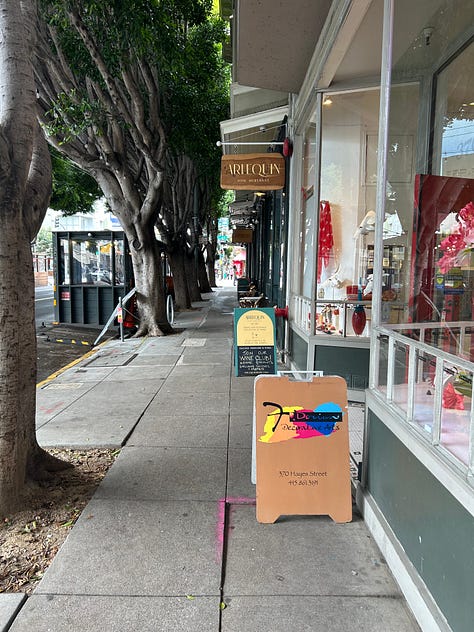

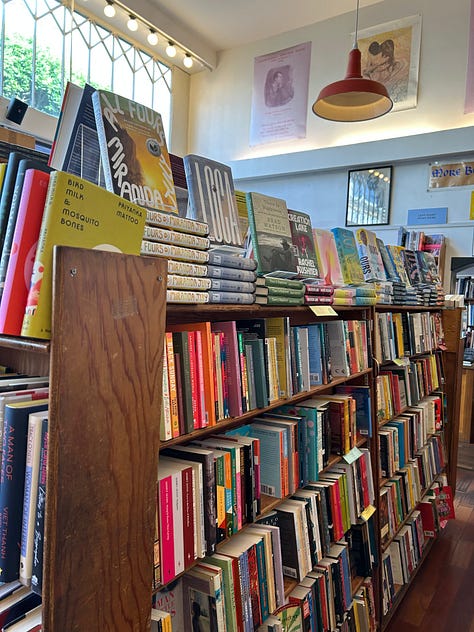
You can walk around a number of neighborhoods in San Francisco, find them to be quite healthy, and wonder why people are fretting over the city. When I first got to town, I walked off my jet lag around Hayes Valley, North Beach, and Japantown – all areas where the streets were clean, stores were occupied, and there were lots of people on the street.
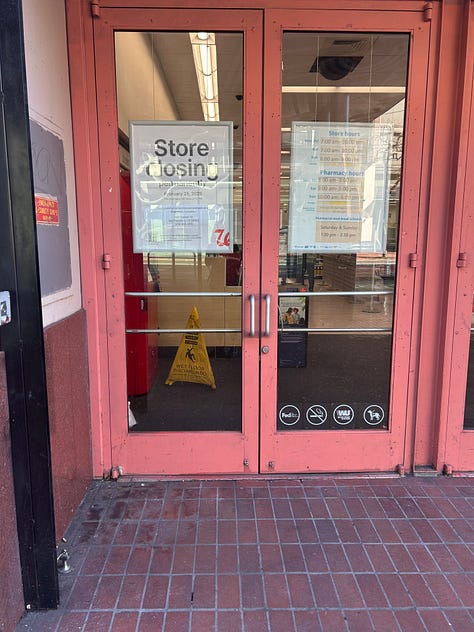
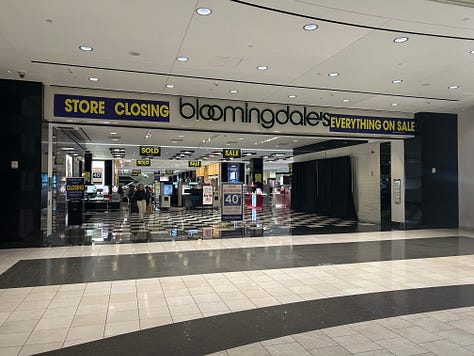
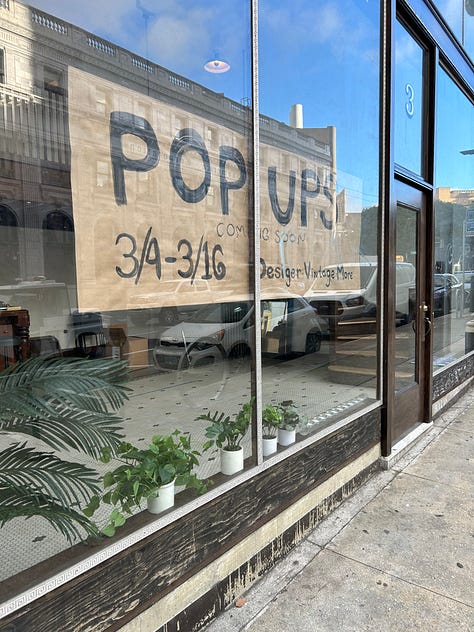
But as I made my way downtown, my sense of the city shifted dramatically.
Much of Market Street retail is unoccupied. Union Square has a decent amount of foot traffic, but is also riddled with vacant storefronts. Maiden Lane, a charming little street that’s got some cute placemaking, had almost no open storefronts. Each time I saw something positive — Levi’s has a flagship store coming soon, thanks mayor! — I saw something negative, like that a cavernous Bloomingdale’s and Walgreen’s were closing. It’s hard to feel like San Francisco is on the brink of a comeback when you see such glaring emptiness, especially in a neighborhood that had been until quite recently a posh shopping district.
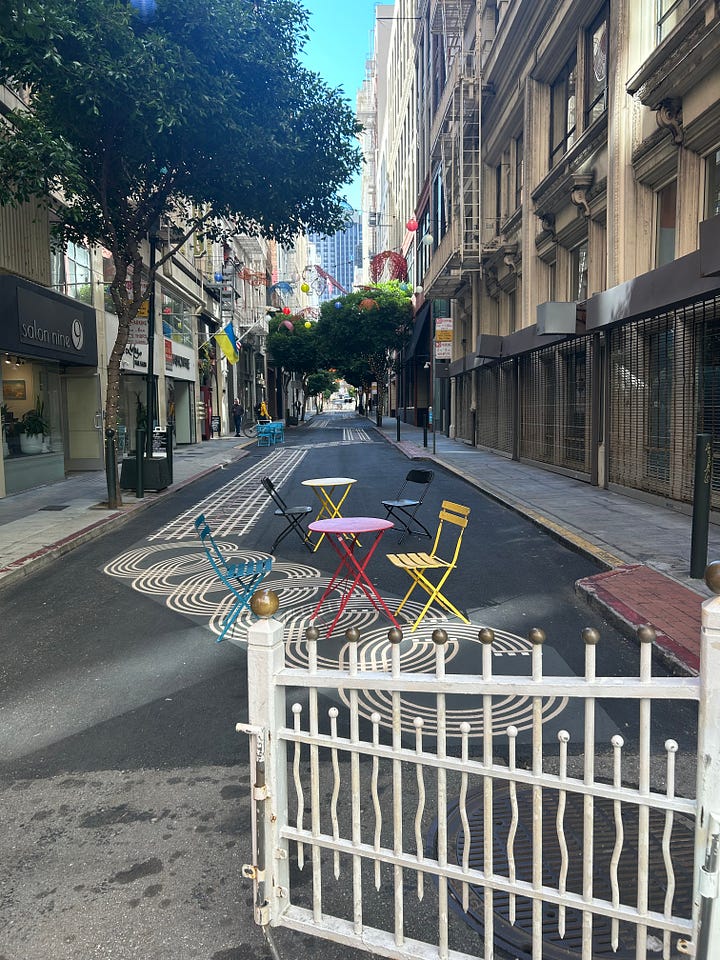
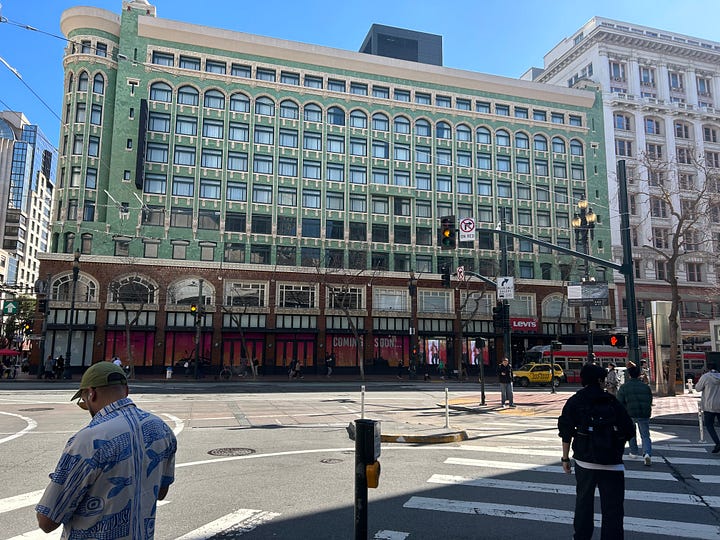
To address the issue of vacant storefronts, the City of San Francisco partnered with the nonprofit, SF New Deal, to create a program, Vacant to Vibrant, that would help get local small businesses into these storefronts through short-term leases.
We met SF New Deal’s Executive Director, Simon Bertrang, at Taylor Jay, one of the new boutiques popping up in Union Square.
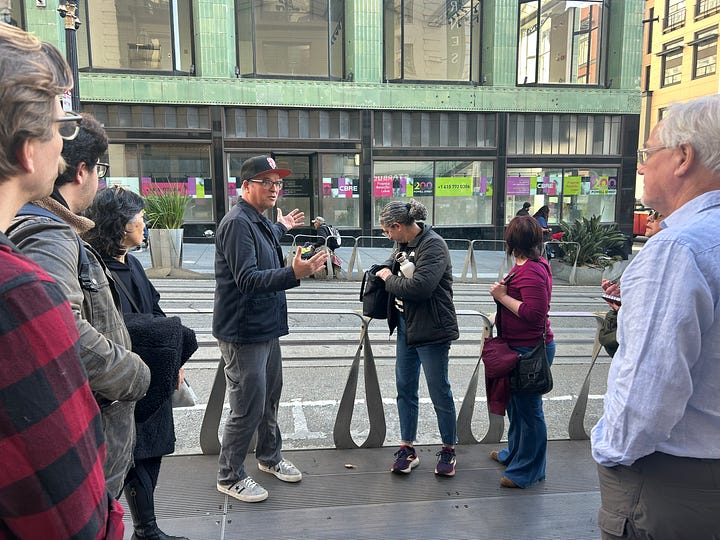

When SF New Deal made the call for businesses to come downtown, they got an overwhelming response: 850 applications for what would ultimately be less than three dozen storefronts through two cohorts of businesses. SF New Deal picked businesses that had their own strong followings so that those businesses would draw people from other neighborhoods downtown, just to visit their stores.
If there’s so much demand to be downtown, why is a program like SF New Deal's Vacant to Vibrant even necessary and why aren’t these storefronts full already?
It turns out that the laws and businesses in and around retail — much like office space — are not made for this moment.
Here are some of the hurdles:
Many small businesses that are looking to go into a storefront have never operated a brick-and-mortar retail operation before.
Landlords are looking for tenants with a history of renting space, and in addition, with enough cash flow and reserves to guarantee a lease for a long period. Ideally more than five years.
Even when you find a good match between landlord and tenant, there’s lease negotiations, which can often involve a lawyer and take weeks to resolve.
Construction, which is especially expensive in the Bay Area, is often required to renovate a space for current needs.
And you need to get insurance.
Added to all these costly issues: San Francisco has extra requirements to deal with earthquakes.
SF New Deal’s value proposition is that they arrange for up to six months of free rent, and deal with the landlords and the difficult stuff above. In addition, because of the partnership with the City, SF New Deal can accelerate the permitting process.
So far, 10 of the tenants have moved beyond their initial short-term leases with Vacant to Vibrant and gone on to sign long-term leases of one-to-five years.
In addition, there’s been a mindset shift from landlords. Getting retail tenants is no longer just about retail revenue. It’s about creating an amenity — or a desirable neighborhood — for the tenants in the offices above the ground floor.
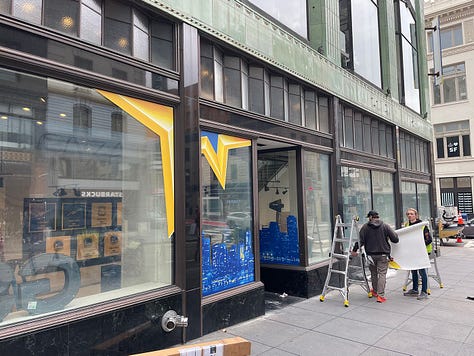
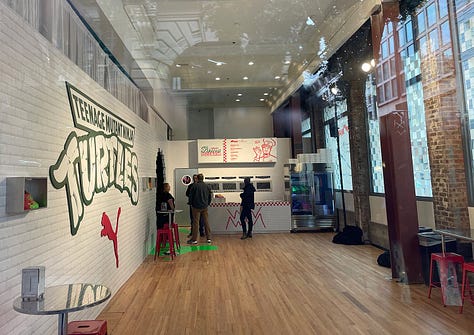
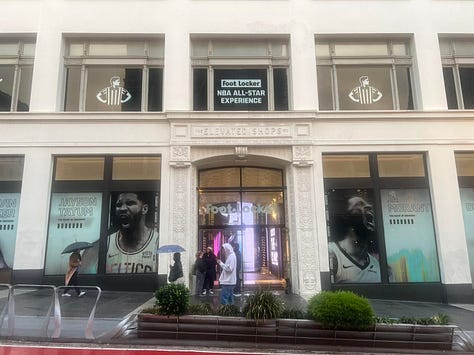
The city also seems now more open to pop-ups, using short retail opportunities to its advantage. For the recent NBA All-Star game, numerous vacant storefront hosted retail such as a Foot Locker and a Teenage Mutant Ninja Turtles pizza shop.
Where to go from here
The future of retail is going to be more experiential — akin to the NBA All-Star pop-ups, but for the longer term. I was surprised by the lack of “competitive socializing” retail, such as indoor mini golf and bowling, in the city — especially since competitive socializing concepts have grown 386 percent since the beginning of 2021, according to Cushman & Wakefield. I’d love to see Vacant to Vibrant do a special cohort that is specifically aimed at local businesses that provide experiences.
It also seemed that downtown needs more concepts like the renovated Ferry Building. The scale of many of the vacancies is too enormous for most local retail at this point. Marketplaces could help carve up large spaces and provide an easier entry point for small businesses. Like the Ferry Building, many of the buildings around Market Street have great historic architecture and views that could also be part of the draw.
Finally, there’s a chicken-and-egg problem with foot traffic and retail. Neighborhood retail is thriving because it has built-in foot traffic. Given the small number of downtown residents, can you drive foot-traffic with retail? I think so, but perhaps not with high-end shops. Ironically, malls have staged a comeback by decreasing their number of boutiques and increasing practical retail like bookstores, urgent cares, kids play zones, and continuing education classes. Moving toward a more pragmatic mix might help Union Square seem like a useful, multi-stop destination for residents, not just tourists.
I was impressed by the inroads that Vacant to Vibrant is making and think a lot of other cities could learn from it. (I was excited to hear that Philadelphia’s Center City District is already comparing notes.) It would be great if San Francisco’s model could not only help resolve its own vacancy crisis but help the dozens of other cities that are grappling with the same problems.
I’ll be back later this week with my next post in the series…….
This work is made possible because each week a handful of people become paying subscribers. Support this work, get behind all the paywalled pieces, see the 10 job listings in each post, and get the first invites to subscriber-only events!
10 job listings
Packard Foundation - Vice President, Families & Communities
District of Columbia. - Program Manager, Downtown Innovation Unit
ICLEI - Resilience Program Officer
Lincoln Institute of Land Policy - Coordinator, Federal Affordable Housing
Boston Public Health Commission - Director of the Office of Violence Prevention
Impactual - Director and Associate positions (remote)
California Policy Lab - several positions
Community Foundation of Utah - Next Gen Philanthropy Program Manager
Terner Center - Associate Research Director, Land Use and Supply








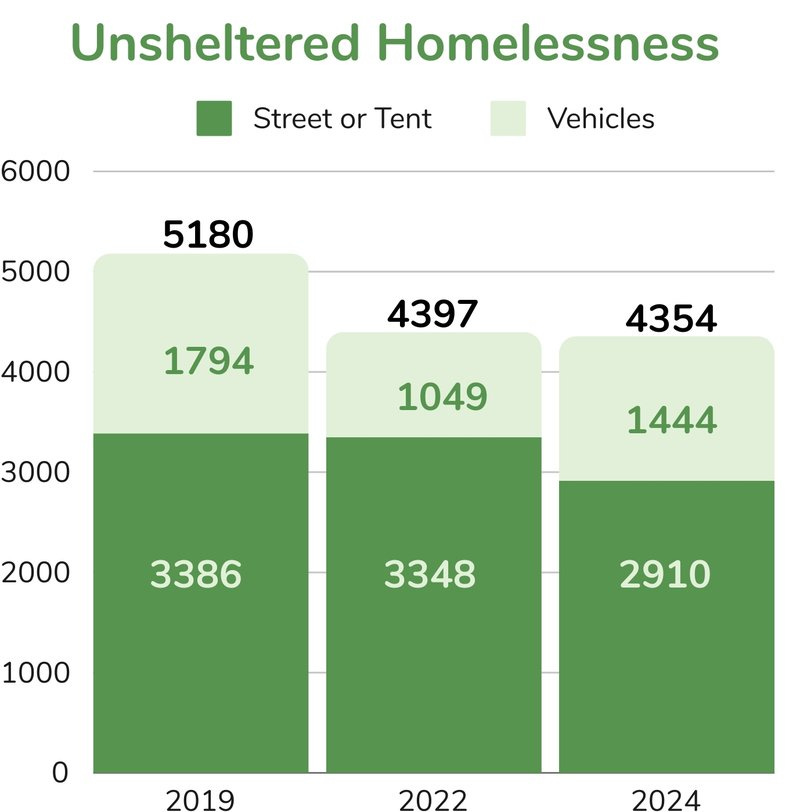
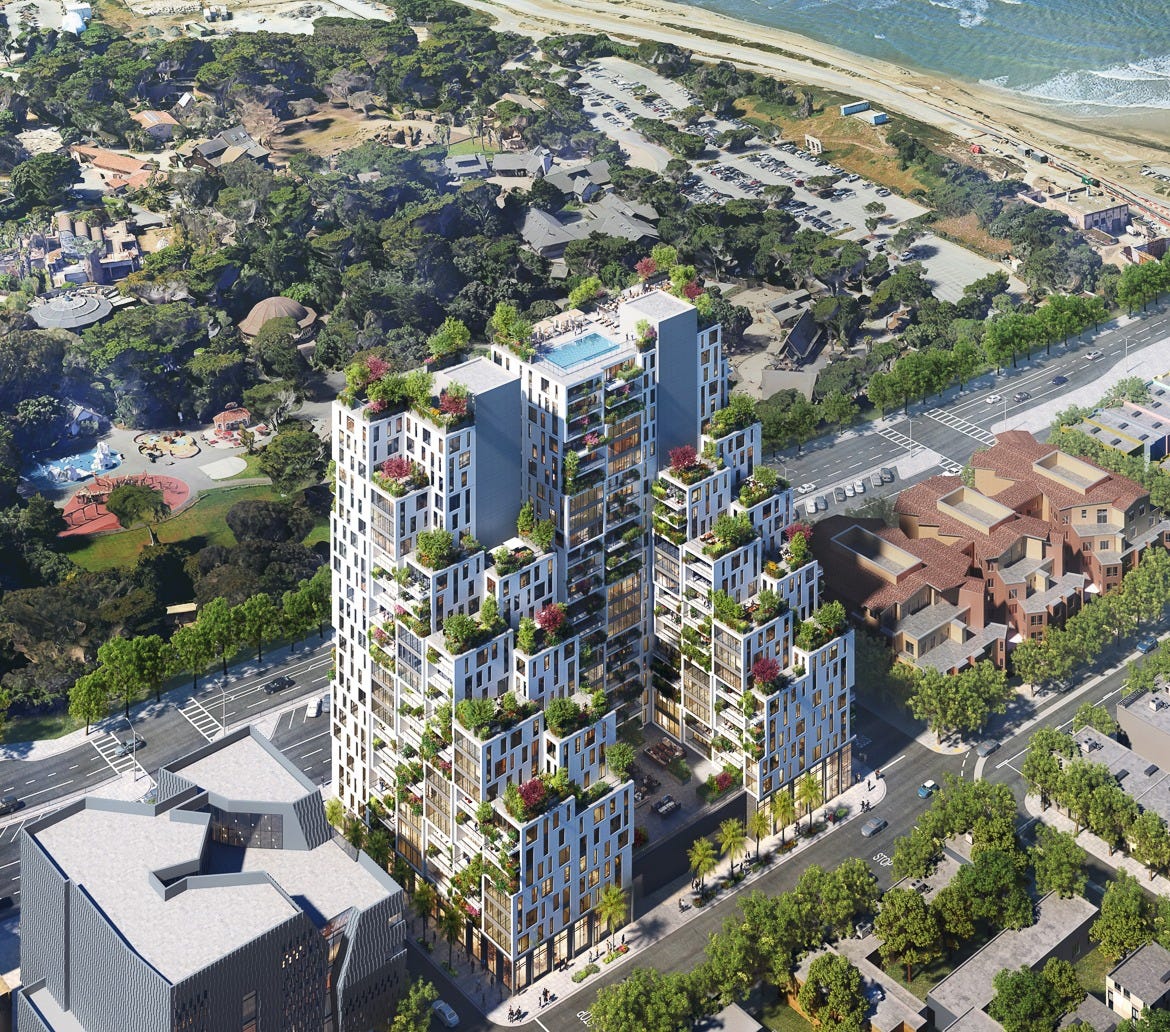
Great analysis. Any thoughts on “car-free” Market St? I’m a proponent of it but it launched the same time as the pandemic so some opponents accuse it of stifling downtown activity.
Also, have commercial retail rents not fallen as much as we would expect? Are they like stubborn home prices?
Donatello, Raphael, Leonardo and Michelangelo were all artists of the Italian Renaissance. Just so you know.